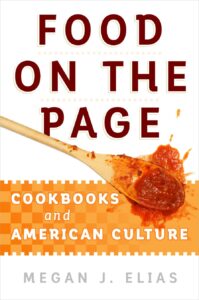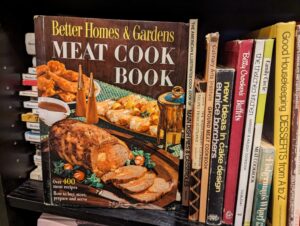Food on the Page: Cookbooks and American Culture – Megan J. Alias
 Food on the Page: Cookbooks and American Culture. By Megan J. Alias. (Philadelphia: University of Pennsylvania Press, 2017. 244 pp. Cloth, $39.95.)
Food on the Page: Cookbooks and American Culture. By Megan J. Alias. (Philadelphia: University of Pennsylvania Press, 2017. 244 pp. Cloth, $39.95.)
I have a confession to make. I love collecting old cookbooks. I ran the cooking section for a bit when I worked at the used bookstore, and we always used to pillory the old cookbooks that came through because the food looked so unappetizing. How, we wondered, could anyone be inspired to cook that? We valued these books as nothing. Now, 12 years away from the very chaotic 20-something me, I realize we missed our opportunity. We should have made a nostalgia cookbook shelf where we could squirrel away all those ridiculous cookbooks so that quirky-minded buyers could enrich their collections with, say, the Better Homes and Garden Ground Beef Cookbook. I know that audience is out there because I am that audience. I scour the selves of our local used bookstore looking for these misunderstood volumes. First my criteria was anything from the 1950s-1970s that looked disgusting. There are a lot of those. Then I expanded my search to include quirky cookbooks from the same time period, like an entire cookbook dedicated to just canned tuna, or a Scottish cookbook with a recipe for haggis. If you can imagine it, and especially if you can’t, it is out there for you.
My obsession with these cookbooks meant I was thrilled to discover Megan J. Elias’s Food on the Page, which promised to take an in-depth look at American cookbooks from the very late 18th century to the present. Most of all, I wanted an investigation into what exactly was going on with the food and images that accompanied the mid-century cookbooks I collect and marvel at. I was a bit disappointed. Elias does have a section on industry cookbooks, and even mentions the Better Homes and Gardens cookbooks (of which I have many, many different volumes) but there’s nothing on the images accompanying the text. In fact, Elias believes that image-based cookbooks are a relatively new phenomenon, but I have to disagree. The imagines in the mid-century cookbooks I collect are front and center, integral advertising for the recipes contained inside. Follow these steps and your food will look as (un)appealing as is pictured here.
I am probably not being very fair to Elias. I walked into her book with some very niche interests. As she states in the introduction, “Cookbooks are full of words about food, but they don’t really tell us what people eat” (1). This means they also don’t tell us about what people thought of those stomach-turning images in my cookbooks, or whether they might look more appealing when encountered as actual cooked foods or with a better photographer.
What Elias does do, and does well, is focus on how American cookbooks instructed their audiences not only on how to cook, but how to feel about the food they cooked, a moving target as fashions changed. This narrative is very interesting, but Elias is a little bit light on context. She assumes a certain familiarity with the time periods she reviews, and I had that foreknowledge, but I can see another reader struggling with putting Elias’s arguments into a historical narrative. As cookbooks changed, so did the times. We need to know more about those times, even if the relationship between the two, and who is driving that change, is not always clear. As Elias says in the epilogue:
The hundreds of cookbooks I read over the course of this project revealed to me that, like all writing genres, cookbooks exist at the pleasure of readers, serving their need for inspiration and reflection. Cookbooks can be useful for practical matters, but for the most part they serve other purposes – reinforcing class identities, establishing communal historical narratives, providing, like other kinds of fiction, a diversion from the reader’s personal experience of the usual. The cookbooks discussed here all performed at least one of these functions and sometimes all of them and more simultaneously (239).
Here Elias is hedging a bit – she is putting the readers front and center instead of the cookbook authors that star in her narrative. By leaving audiences for these cookbooks out of the scope of her work, she misses a crucial part of how these cookbooks worked in each of their time periods. Overall, this books lacks a bit of depth, as Elias moves quickly between topics and gives some only superficial treatment. A chapter naming Julia Child in the title barely discusses who she was or the reason for her popularity, only going into details about those who opposed her philosophy. Elias tends to do this throughout – privileging one point of view without really giving a clear picture of the other. And without any sort of understanding of reception, the arguments unravel a bit. I refuse to believe that there aren’t ways to know how people reacted to or drove changing trends in cookbooks. She examines many periodicals and indicates that several published reader letters. That would have been a good place to start.
This book is a light read, perhaps because it skims topics briefly without giving a lot of context or evenly representing opposing views. The last chapter on current food trends was especially interesting, especially as Elias poked holes in Michael Pollan’s arguments put forth in The Omnivore’s Dilemma and In Defense of Food. I found reading Pollan to be a mixed bag – interesting subject matter with an off-putting self-important tone, so I was interested to hear a counter to his arguments.
I think the most important takeaway from this book is that all food culture is a construction. What we eat and what we think about what we eat changes over time depending on the needs and beliefs of cooks (professional or lay) and those ingesting the food. Cooking is a culture in and of itself, and everyone involved is constantly being offered a variety of options for how they can participate in that culture. Food on the Page is a good start toward how to understand that culture, but to do so, we need to understand more than just those attempting to make the rules.

